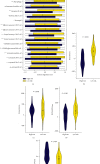A Novel Defined RAS-Related Gene Signature for Predicting the Prognosis and Characterization of Biological Function in Osteosarcoma
- PMID: 36052285
- PMCID: PMC9427258
- DOI: 10.1155/2022/5939158
A Novel Defined RAS-Related Gene Signature for Predicting the Prognosis and Characterization of Biological Function in Osteosarcoma
Abstract
Background: Osteosarcoma (OS) is the most common primary bone malignancy in children and adolescents with a high incidence and poor prognosis. Activation of the RAS pathway promotes progression and metastasis of osteosarcoma. RAS has been studied in many different tumors; however, the prognostic value of RAS-associated genes in OS remains unclear. On this basis, we investigated the RAS-related gene signature and explored the intrinsic biological features of OS.
Methods: We obtained RNA transcriptome sequencing data and clinical information of osteosarcoma patients from the TARGET database. RAS pathway-related genes were obtained from the KEGG pathway database. Molecular subgroups and risk models were developed using consensus clustering and least absolute shrinkage and selection operator (LASSO) regression, respectively. ESTIMATE algorithm and ssGSEA analysis were used to assess the tumor microenvironment and immune penetrance between the two groups. A comprehensive review of gene ontology (GO) and KEGG analyses revealed inherent biological functional differences between the two groups.
Results: The consistent clustering showed stratification of osteosarcoma patients into two subtypes based on RAS-associated genes and provided a robust prediction of prognosis. A risk model further confirmed that RAS-related genes are the best prognostic indicators for OS patients. GO analysis showed that GDP/GTP binding, focal adhesion, cytoskeletal motor activity, and cell-matrix junctions were associated with the RAS-related model group. Furthermore, RAS signaling in osteosarcoma based on KEGG analysis was significantly associated with cancer progression, with immune function and tumor microenvironment particularly affected.
Conclusion: We constructed a prognostic model founded on RAS-related gene and demonstrated its predictive ability. Then, furtherly exploration of the molecular mechanisms and immune characteristics proved the role of RAS-related gene in the dysregulation in OS.
Copyright © 2022 Qin Chen et al.
Conflict of interest statement
The authors declare that they have no conflicts of interest.
Figures







Similar articles
-
Advances in prognostic models for osteosarcoma risk.Heliyon. 2024 Mar 26;10(7):e28493. doi: 10.1016/j.heliyon.2024.e28493. eCollection 2024 Apr 15. Heliyon. 2024. PMID: 38586328 Free PMC article. Review.
-
Identification and characterization of aging/senescence-induced genes in osteosarcoma and predicting clinical prognosis.Front Immunol. 2022 Oct 5;13:997765. doi: 10.3389/fimmu.2022.997765. eCollection 2022. Front Immunol. 2022. PMID: 36275664 Free PMC article.
-
An Intratumor Heterogeneity-Related Signature for Predicting Prognosis, Immune Landscape, and Chemotherapy Response in Colon Adenocarcinoma.Front Med (Lausanne). 2022 Jul 7;9:925661. doi: 10.3389/fmed.2022.925661. eCollection 2022. Front Med (Lausanne). 2022. PMID: 35872794 Free PMC article.
-
Ferroptosis-related gene signature associates with immunity and predicts prognosis accurately in patients with osteosarcoma.Cancer Sci. 2021 Nov;112(11):4785-4798. doi: 10.1111/cas.15131. Epub 2021 Sep 21. Cancer Sci. 2021. PMID: 34506683 Free PMC article.
-
Prognostic signature and immunotherapeutic relevance of Focal adhesion signaling pathway-related genes in osteosarcoma.Heliyon. 2024 Sep 26;10(21):e38523. doi: 10.1016/j.heliyon.2024.e38523. eCollection 2024 Nov 15. Heliyon. 2024. PMID: 39524888 Free PMC article.
Cited by
-
Amicis Omnia Sunt Communia: NF-κB Inhibition as an Alternative to Overcome Osteosarcoma Heterogeneity.Pharmaceuticals (Basel). 2024 Jun 5;17(6):734. doi: 10.3390/ph17060734. Pharmaceuticals (Basel). 2024. PMID: 38931401 Free PMC article. Review.
-
Clinical and therapeutical significances of the cluster and signature based on oxidative stress for osteosarcoma.Aging (Albany NY). 2023 Dec 29;15(24):15360-15381. doi: 10.18632/aging.205354. Epub 2023 Dec 29. Aging (Albany NY). 2023. PMID: 38180104 Free PMC article.
-
T cell receptor signaling pathway subgroups and construction of a novel prognostic model in osteosarcoma.Heliyon. 2024 Dec 12;11(1):e41191. doi: 10.1016/j.heliyon.2024.e41191. eCollection 2025 Jan 15. Heliyon. 2024. PMID: 39811323 Free PMC article.
-
Advances in prognostic models for osteosarcoma risk.Heliyon. 2024 Mar 26;10(7):e28493. doi: 10.1016/j.heliyon.2024.e28493. eCollection 2024 Apr 15. Heliyon. 2024. PMID: 38586328 Free PMC article. Review.
-
The Rat Sarcoma Virus (RAS) Family of Proteins in Sarcomas.Cureus. 2024 Mar 27;16(3):e57082. doi: 10.7759/cureus.57082. eCollection 2024 Mar. Cureus. 2024. PMID: 38681356 Free PMC article. Review.
References
-
- Ottaviani G., Jaffe N. The epidemiology of osteosarcoma. Cancer Treatment and Research . 2009;152:3–13. - PubMed
LinkOut - more resources
Full Text Sources

